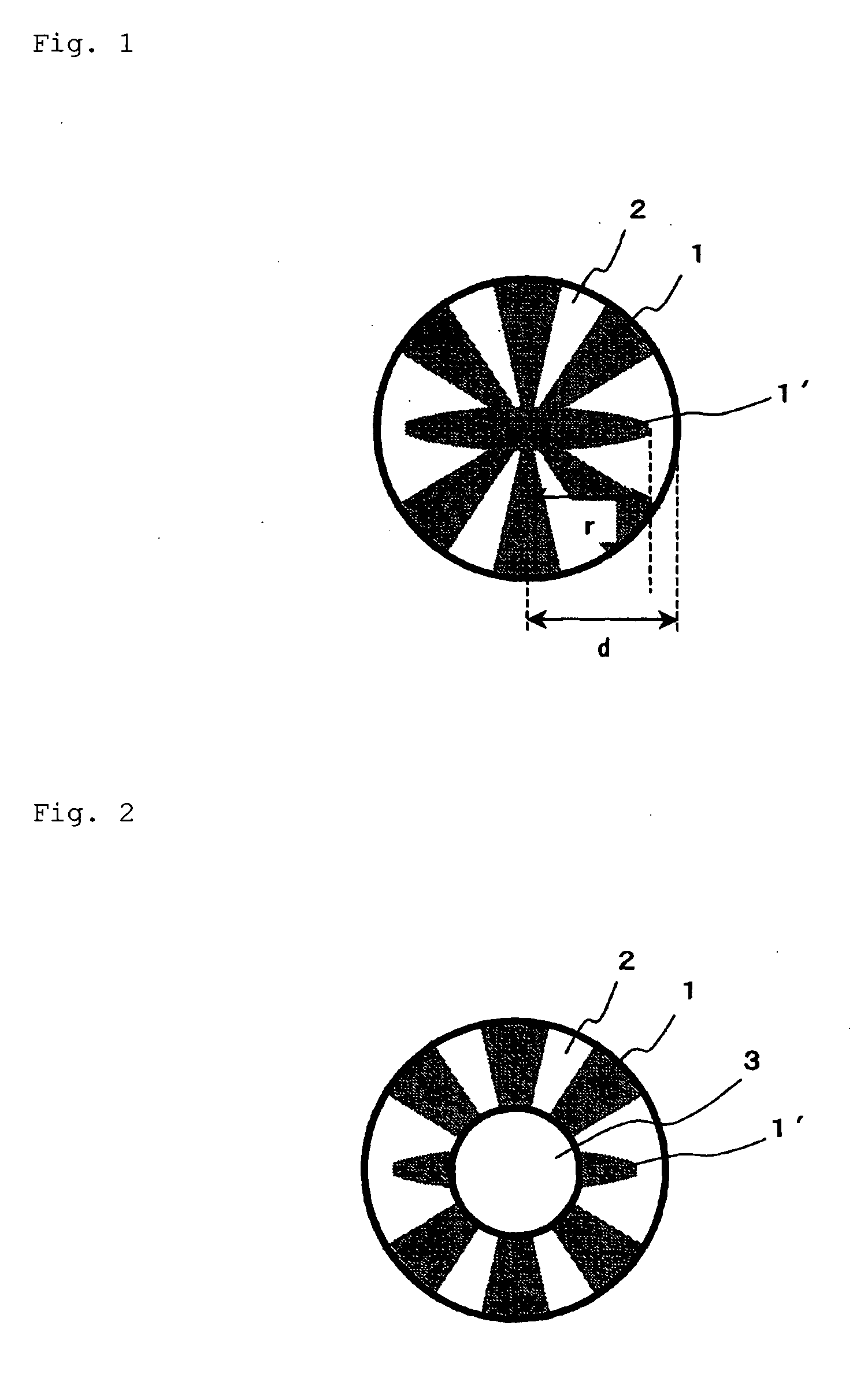Splittable conjugate fiber, aggregate thereof, and fibrous form made from splittable conjugate fibers
a technology of conjugate fibers and aggregates, which is applied in the direction of weaving, yarn, transportation and packaging, etc., can solve the problems of difficult processing and use of polyolefin conjugate fibers, poor texture of nonwoven fabrics, and inability to be economical, so as to achieve good splittability, high thermal bondability, and easy to split fibers
- Summary
- Abstract
- Description
- Claims
- Application Information
AI Technical Summary
Benefits of technology
Problems solved by technology
Method used
Image
Examples
example
[0063]The invention will be explained below in detail by reference to Examples. However, the invention should not be limited thereto. Methods used for determining property values shown in the Examples or the definitions of the properties are shown below.
[0064]Measurement was made in accordance with JIS-L-1015.
(2) Single-Yarn Strength and Elongation
[0065]Measurement was made with Autograph AGS 500D, manufactured by Shimadzu Corp., in accordance with JIS-L-1017 under the conditions of a sample length of 100 mm and a tensile rate of 100 mm / min.
(3) Melt Flow Rate Rate (MFR)
[0066]Measurement was made in accordance with JIS-K-7210.
[0067]Raw-material polypropylene resin: conditions 14
(4) Limiting Viscosity (IV)
[0068]Measurement was made with an Ubbellohde viscometer at 20° C. (in a 1:1 (by mass ratio) mixed solvent of phenol and tetrachloroethane).
(5) Spinnability
[0069]Stringiness when melt spinning was evaluated in the following four grades in terms of the number o...
examples 1 and 2
[0083]Polyethylene terephthalate having a melting point of 260° C. as a polyester component and polypropylene having a melting point of 160° C. and an MFR of 16 in Example 1 or polypropylene having a melting point of 160° C. and an MFR of 30 in Example 2 as a polyolefin component were spun at a spinning temperature of 280° C. through a nozzle for a splittable conjugate fiber. The resin discharged from the spinning nozzle was cooled with cooling air of 25° C. at a wind velocity of 1.7 m / sec to obtain an aggregate of splittable conjugate fibers. The aggregate of splittable conjugate fibers had a polyester / polyolefin volume ratio of 50 / 50 and a single-yard fineness of 5.4 dtex. The aggregate of splittable conjugate fibers comprises the splittable conjugate fiber having a cross-sectional configuration representatively illustrated in FIG. 2, in which at least one convex portion of the polyester segment is exposed at the outer edge of the fiber and at least one convex portion of the polye...
example 3
[0085]Polyethylene terephthalate having a melting point of 260° C. as a polyester component and polypropylene having a melting point of 160° C. as a polyolefin component were spun at a spinning temperature of 280° C. through a nozzle for a splittable conjugate fiber. The resin discharged from the spinning nozzle was cooled with cooling air of 25° C. at a wind velocity of 1.7 m / sec to obtain an aggregate of splittable conjugate fibers. The aggregate of splittable conjugate fibers had a polyester / polyolefin volume ratio of 50 / 50 and a single-yard fineness of 5.4 dtex. The aggregate of splittable conjugate fibers comprises the splittable conjugate fiber having a cross-sectional configuration representatively illustrated in FIG. 2, in which at least one convex portion of the polyester segment is exposed at the outer edge of the fiber and at least one convex portion of the polyester segment is unexposed at the outer edge of the fiber, in a proportion of 80%. The MFR of the polypropylene ...
PUM
| Property | Measurement | Unit |
|---|---|---|
| melting point | aaaaa | aaaaa |
| velocity | aaaaa | aaaaa |
| temperature | aaaaa | aaaaa |
Abstract
Description
Claims
Application Information
 Login to View More
Login to View More - R&D
- Intellectual Property
- Life Sciences
- Materials
- Tech Scout
- Unparalleled Data Quality
- Higher Quality Content
- 60% Fewer Hallucinations
Browse by: Latest US Patents, China's latest patents, Technical Efficacy Thesaurus, Application Domain, Technology Topic, Popular Technical Reports.
© 2025 PatSnap. All rights reserved.Legal|Privacy policy|Modern Slavery Act Transparency Statement|Sitemap|About US| Contact US: help@patsnap.com


